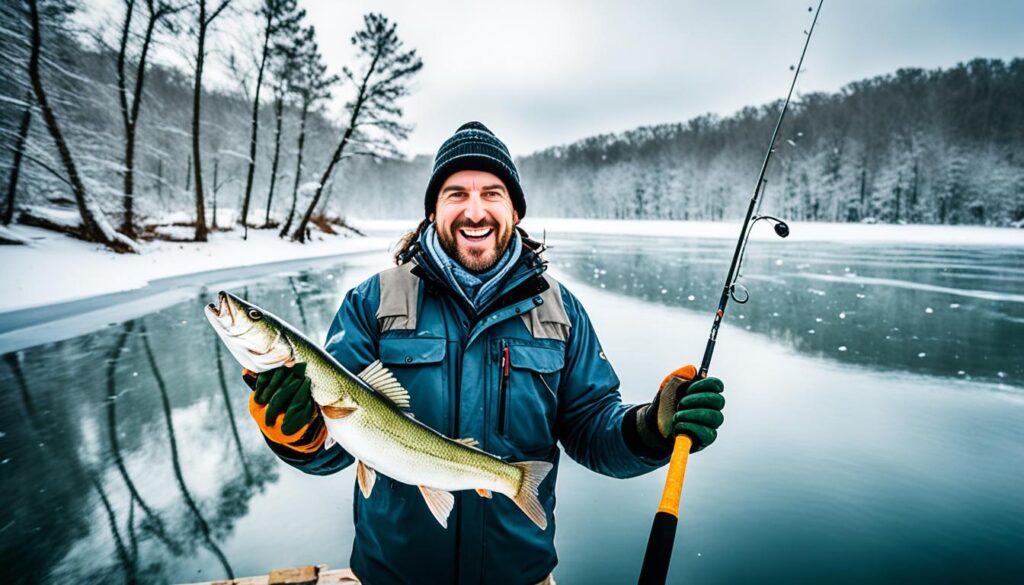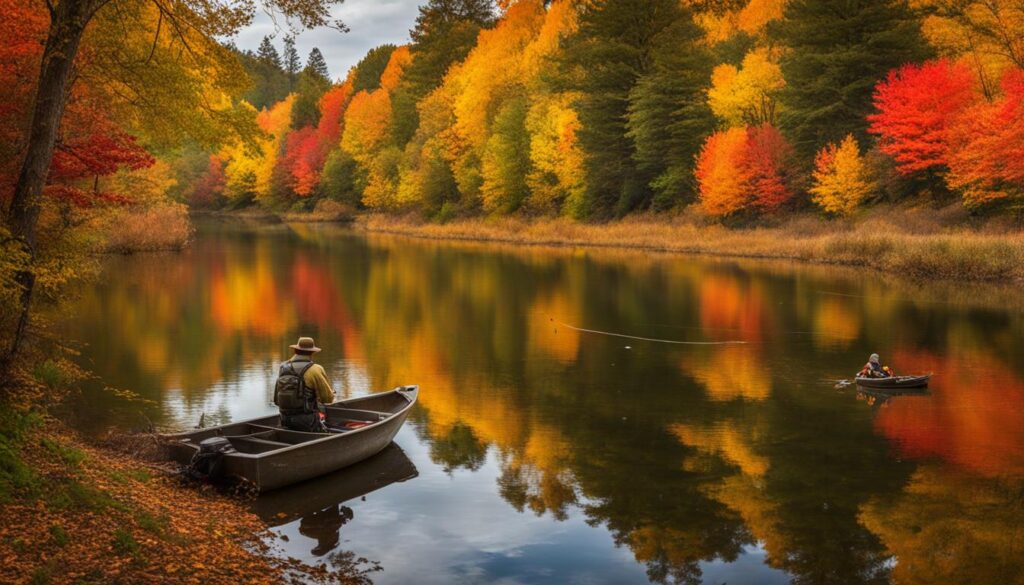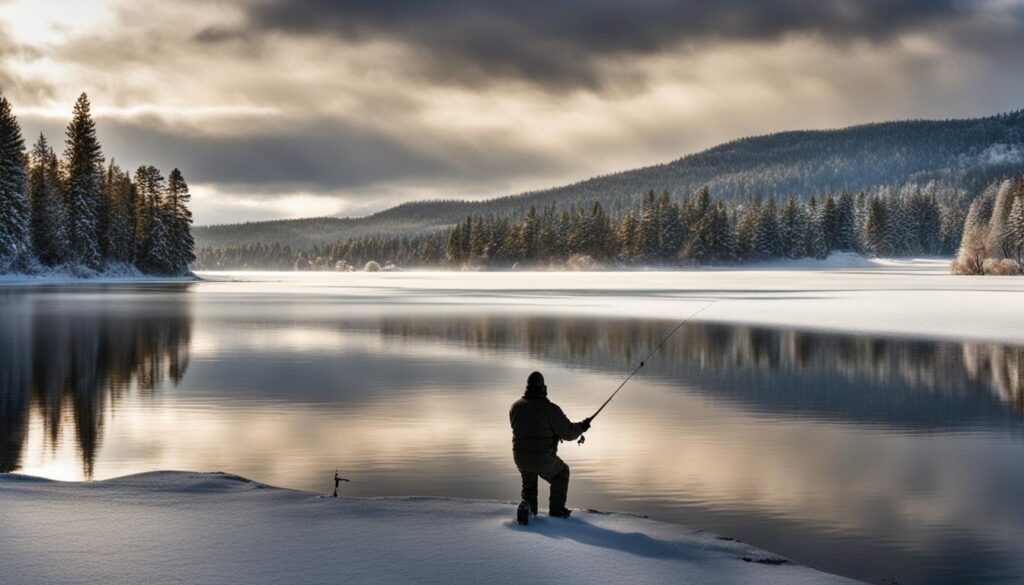When the winter chill sets in, many anglers hang up their rods and wait for warmer days. But for the dedicated angler, winter fishing can be a rewarding experience. With the right techniques and understanding of the behavior of bass in cold water, you can increase your chances of success even in the coldest months.
One effective strategy for wintertime success is the 1-2 punch of jerkbaits and drop-shot rigs. These techniques have proven to be highly effective in enticing bites from sluggish bass in cold water. Jerkbaits, with their erratic swimming action, mimic injured baitfish and can trigger strikes even when bass are less active. Drop-shot rigs, on the other hand, offer a finesse presentation that keeps the bait in the strike zone for longer, increasing your chances of enticing a bite.
By employing these techniques and adapting to the unique challenges of winter fishing, you can unlock the secret to wintertime success. In this article, we will explore winter fishing tips, cold-water fishing techniques, and how to adapt to changing conditions for a successful fishing experience even in the frosty months ahead.
Key Takeaways:
- Utilize jerkbaits and drop-shot rigs for wintertime success in cold water
- Understand the behavior of bass in winter to determine effective techniques
- Adapt to changing conditions by observing bird activity and using quality electronics
- Dress appropriately and protect fishing equipment in cold weather
- Patience and persistence are key to achieving success in winter fishing
Small Pond Fishing Techniques
When the chill starts to bite in late fall and early winter, mastering the art of small pond fishing becomes all the more crucial. To reel in those elusive bass, trout, or panfish, having the proper bait arsenal at your disposal can make all the difference. Here’s a rundown of practical techniques and bait recommendations tailored for small pond fishing:
Topwater Baits
Regarding enticing bites from fish cruising near the water’s surface, few options rival the allure of topwater baits. Consider classics like the Heddon Spook Jr., the Gambler Cane Toad, or the Spro Bronzeye Frog. Cast these tantalizing baits around covers such as lily pads, fallen trees, or docks, employing a steady retrieval technique to mimic wounded prey and provoke aggressive strikes.
Suspending Baits
Suspension baits are indispensable for imitating the erratic movements of injured baitfish. Equip your tackle box with essentials like the Rapala X-Rap jerkbait, the Lunker City Slug-Go, or the trusty Zoom Fluke. Experiment with retrieval speeds, twitches, and pauses to replicate the vulnerability of injured prey, enticing bites from wary fish lingering in small pond depths.
Mid-Water Baits
Mid-water baits come into their own when targeting fish suspended slightly below the surface or cruising in open water. Opt for versatile options like crankbaits or lipless crankbaits, which are perfect for bouncing off submerged logs or rocky formations. Vary your retrieval speed to mimic natural prey behavior, triggering reaction strikes from lurking fish.
Bottom Baits
When fish hunker near the pond floor, it’s time to break out the bottom baits. Finesse jigs and Zoom Ol’ Monster worms excel at mimicking crawfish or bluegill, enticing even the most reticent of fish. Employ a slow, methodical retrieve near structure or along drop-offs to replicate the subtle movements of natural prey, luring in your following trophy catch.
In the realm of small pond fishing, patience and experimentation are not just important; they’re the keys to success. Test different techniques, tweak your retrieves, and stay attuned to the behaviore of your quarry. Armed with thes techniques and the right bait selection, you’ll be primed for thrilling catches amidst the late fall and early winter tranquility.
Reservoir Fishing Techniques
When tackling winter fishing in reservoirs, a distinct strategy comes into play. Veteran anglers have uncovered effective techniques for targeting bass within these expansive bodies of water. One notable approach involves honing in on schooling bass, often congregating around points, ridges, humps, and funnels—key gathering spots for these elusive fish.
The versatile drop-shot rig adorned with enticing green pumpkin lures is a favored presentation for offshore fishing in reservoirs. The subtle movements of this setup have a knack for luring bites from deep-dwelling bass. By adeptly adjusting the leader length and weight positioning, anglers can precisely target fish at varying depths, making this tactic a stalwart choice for tackling reservoirs.
When it comes to shallower waters, crankbaits take center stage as a preferred lure option. Brands like Rapala offer reliable choices, such as the renowned Shad Rap and DT6. When maneuvered near cover, these shallow-water baits are known for provoking reaction strikes from lurking bass. Employing a repertoire of retrieval techniques—from steady retrieves to erratic ripping or yo-yo’ing—unveils the most enticing presentation for enticing bites.
Another fruitful method for zeroing in on shallow-dwelling fish in reservoirs is the strategic deployment of flipping jigs. Outfitted with a sturdy weed guard and boasting a substantial profile, these jigs penetrate dense cover and mimic the movements of baitfish or crawfish. Precision in bait placement within the shallow strike zone ensures optimal chances of enticing bites from wary bass.
“When fishing reservoirs in winter, location is key. Look for areas where bass tends to school, and focus your efforts there.”

The Rapala Shad Rap and DT6 are highly effective crankbaits for shallow bass in reservoirs.
In addition to the tactics above, incorporating lipless crankbaits or rattletraps can significantly enhance your chances of success when tackling reservoirs. These versatile baits offer many fishing techniques, from aggressive ripping and yo-going to steady retrieval. By experimenting with these varied approaches, you can discern which elicits the most favorable response from bass inhabiting your local reservoir.
Integrating these reservoir fishing techniques into your repertoire can bolster your odds of success during winter. Whether targeting the depths or stalking the shallows for bass, tailoring your presentation and lure selection to the specific nuances of the reservoir’s conditions will elevate your fishing expedition.
Color Choices:
Color selection is pivotal for fall fishing triumphs. Emulate local forage with bait patterns resembling shad, crawfish, or bluegill. Opt for natural hues like silver, white, green pumpkin, and watermelon, or blend these shades for maximum effectiveness.
Stay adaptable as fall fishing conditions fluctuate. Fine-tune your presentation techniques and remain attuned to shifting weather patterns. You’ll amplify your prospects for a triumphant fall fishing outing with the right baits, varied retrieval methods, and astute color choices.

Challenges of Winter Fishing
Winter fishing poses unique challenges, demanding adaptability to shifting weather conditions, water temperatures, and fish behavior. As temperatures plummet, bass grows sluggish, mandating presentation and retrieval techniques adjustments to provoke strikes. Swift weather shifts further complicate matters, prompting fish to become more discerning in their feeding habits.
Vigilantly monitoring water temperatures proves pivotal in navigating winter’s trials. This data empowers anglers to calibrate their approach, aligning it with the fish’s activity levels. Anticipating the repercussions of changing weather and tailoring fishing tactics substantially heightens the likelihood of success on the water.
During winter fishing expeditions, keep these essentials in mind:
- Observe water temperatures and tailor presentation techniques accordingly.
- Stay abreast of weather forecasts to anticipate rapid changes.
- Experiment with diverse bait options and retrieval methods to lure strikes.
The Impact of Water Temperature
Water temperature stands as a linchpin in dictating fish behavior and feeding routines. Plunging temperatures decelerate bass metabolism, diminishing their activity levels. In response, anglers pivot to slower presentations and finesse techniques, mirroring natural prey movements to entice bites. Tactics like jigging spoons, drop-shot rigs, and leisurely retrieves are potent in eliciting lethargic winter bass strikes.
Moreover, astute attention to water temperature aids in pinpointing hotspots teeming with active fish. Shallow zones, basking in the sun’s warmth, beckon bass in search of slightly elevated temperatures. Proficiency in correlating water temperature shifts with fish behavior nuances is pivotal in refining one’s approach for optimal winter fishing outcomes.
Adapting to Changing Weather Conditions
Winter’s erratic weather, marked by abrupt temperature swings and atmospheric fluctuations, poses a challenge. These erratic shifts compel fish to refine their feeding preferences, demanding anglers to diversify bait presentations. By experimenting with varied bait options and adjusting techniques to match prevailing conditions, anglers can allure bites from selective fish. Vigilance in monitoring weather forecasts aids in strategic trip planning, elevating prospects for fruitful outings on the water.
Monitoring Fish Behavior
A nuanced understanding of fish behavior underpins success in winter fishing endeavors. As temperatures dip, bass gravitate towards deeper structures like drop-offs and points, seeking optimal survival conditions. Additionally, baitfish presence influences bass feeding patterns, with opportunistic hunting tendencies prevailing in colder waters. Attentiveness to avian activity, such as diving birds or congregating gulls, is a reliable indicator of feeding fish nearby.

Fishing in Cold Water
Cold water fishing demands a strategic adjustment of techniques to allure and hook lethargic fish effectively. You can still reel in a rewarding catch even amidst frosty conditions with a tailored approach. Here are some indispensable tips to elevate your cold-water fishing prowess:
1. Slow Retrieves
Fish exhibit diminished activity levels in chilly waters, often shying away from swift pursuits. Opting for slow retrieves mirrors the languid movements of prey, enticing cautious fish to strike. By decelerating your presentation, you afford fish ample time to detect and engage with your bait.
2. Finesse Techniques
Integrating finesse techniques into your cold water fishing repertoire proves invaluable. Drop-shot rigs and jigging spoons excel in enticing strikes from less active fish. These subtle presentations allure even the most cautious fish, offering a compelling temptation they find hard to resist.
3. Fluorocarbon Line Sensitivity
Leveraging the fluorocarbon line heightens your sensitivity to subtle movements, amplifying your ability to detect delicate bites. The fluorocarbon line grants you a distinct advantage with its reduced visibility underwater and enhanced sensitivity compared to monofilament. Every nibble on your line becomes palpable, empowering you to respond swiftly and secure your catch.
Remember, success in cold-water fishing hinges on patience and perseverance. While fish may exhibit subdued aggression, they remain within reach with the right tactics. Adapt your approach, incorporate deliberate retrieves and finesse techniques, and capitalize on fluorocarbon line sensitivity to tip the scales in your favor and ensure a fruitful fishing outing.
Adapting to Changing Conditions
Adapting to the dynamic conditions of winter fishing is paramount for a successful angling experience. As weather patterns fluctuate and the environment undergoes transformations, anglers must remain agile, ready to tweak their strategies for a shot at landing the elusive bass.
A prime tactic for adaptation involves keen observation of bird activity. Birds serve as reliable indicators of baitfish presence, offering valuable cues to potential feeding zones for bass. Keep a watchful eye on the behavior of diving birds, as their movements often signify the presence of baitfish schools near the water’s surface.
Pro angler Mark Thompson underscores the significance of avian cues, stating, “Birds can be a valuable source of information when finding active fish. If you see seagulls or other diving birds in an area, it’s a good sign that baitfish are present, and bass won’t be far behind.”
In addition to avian insights, quality electronics serve as indispensable aids. Fish and depth finders enable anglers to pinpoint schools of bass, facilitating precise adjustments in presentation. Identifying the depth at which fish congregate allows for targeted approaches, maximizing the likelihood of success.
Lastly, embracing versatility in presentation is critical. Winter bass can be discerning, necessitating experimentation with an array of techniques. From drop-shotting to crankbaits and jigging spoons, exploring diverse methods is crucial for enticing bites from selective fish. Stay adaptable and open-minded, ready to pivot until discovering the winning formula for prevailing conditions.
Conclusion
In conclusion, staying updated with fishing reports informs your strategy, while proper clothing and gear maintenance is essential for cold-weather outings. Techniques like jerkbaits and drop-shot rigs prove effective in winter, but adaptability is critical. Observing bird activity, utilizing electronics, and varying presentations optimize your chances. Winter fishing demands patience and persistence, but with the right approach, the rewards are plentiful.
FAQ
What are some effective techniques for winter fishing?
Two highly effective techniques for winter fishing are jerkbait and drop shot fishing. These techniques can help you entice bites from bass in cold water conditions.
What are some recommended fishing techniques for small ponds in winter?
In small ponds during winter, topwater baits like Spook Jr., Cane Toad, and Bronzeye Frog can be productive. Additionally, suspending baits like X-Rap jerkbait, Shu-Shu Slug, and Zoom Fluke, as well as mid-water baits like crankbaits and lipless crankbaits, and bottom baits like finesse jigs and Ol’ Monster worms can attract bites.
What are some effective techniques for fishing in reservoirs during winter?
When fishing in reservoirs during winter, it is important to target schooling bass. Effective techniques include using drop-shot rigs, jigging spoons, lipless crankbaits, and spinnerbaits. These presentations can help you catch bass both in deep and shallow areas of the reservoir.
What are some winter fishing tips for anglers in Georgia?
In Georgia, popular baits for winter fishing include drop-shot rigs, jigs, crankbaits, lipless crankbaits, and spinnerbaits. The preferred bait colors vary based on water clarity. Anglers also recommend using medium-heavy or medium-action rods paired with appropriate reels and line for each presentation.
What are some tips for pond fishing in Louisiana during late fall and early winter?
The best times for pond fishing in Louisiana during late fall and early winter are the day before a cold front and two days after a cold front. Effective baits for this season include topwater baits like Spook Jr., Cane Toad, and Bronzeye Frog, as well as suspending baits, mid-water baits, and bottom baits.
What are some tips for successful fall fishing?
During fall fishing, it is important to select the right baits based on the desired presentation depth. Topwater baits are great for surface action, suspending baits work well for mid-depth presentations, and bottom baits are effective for targeting fish on the bottom. Vary your retrieving techniques and choose bait colors that imitate local forage.
What are some challenges of winter fishing?
Winter fishing presents challenges such as changing weather conditions and water temperatures, which can make bass less active and more selective in their feeding. Anglers need to adjust their presentation and retrieve techniques accordingly to increase their chances of success.
What are some techniques for fishing in cold water?
In cold water, slow retrieves are often more effective in enticing bites from lethargic fish. Finesse techniques such as drop-shot rigs and jigging spoons can be successful. Using fluorocarbon line can enhance sensitivity, allowing you to detect subtle bites.
How can anglers adapt to changing conditions for successful winter fishing?
Anglers can adapt to changing conditions by observing bird activity to identify feeding areas. Using quality electronics helps locate schools of bass and adjust the presentation accordingly. Exploring different techniques like drop-shotting, crankbaiting, and jigging spoons can increase the chances of finding what works best.
What are some best practices for cold-weather angling?
Researching fishing reports can provide valuable insights into recent fish activity and successful techniques. It is important to dress appropriately with layered clothing and waterproof gear to stay warm and comfortable. Protecting fishing equipment from freezing temperatures is crucial. Being prepared and taking necessary precautions can enhance the cold-weather angling experience.
What are the key takeaways for winter fishing success?
Winter fishing success can be achieved by using a 1-2 punch approach of jerkbaits and drop-shot rigs. It’s important to understand the behavior of bass in winter, choose the right bait presentations, and adapt to changing conditions. Patience and persistence are key to catching impressive winter bass.
